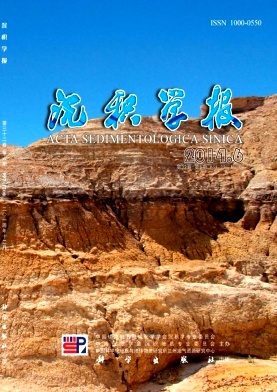|
[1]
|
马安来,李贤庆,熊波,等. 松辽盆地齐家古龙地区烃源岩有机岩石学研究[J]. 石油勘探与开发,2002,29(4):26-28[Ma Anlai, Li Xianqing, Xiong Bo, et al. Organic petrology of the source rocks in Qijia-Gulong region, Songliao Basin [J]. Petroleum Exploration and Development, 2002, 29(4): 26-28] |
|
[2]
|
杨万里,李永康,高瑞琪,等. 松辽盆地陆相生油母质的类型与演化模式[J]. 中国科学,1981,11(8):1000-1008[Yang Wanli, Li Yongkang, Gao Ruiqi, et al. Type and evolution model of continental kerogen in the Songliao Basin[J]. Science in China, 1981, 11(8): 1000-1008] |
|
[3]
|
高瑞琪,蔡希源. 松辽盆地油气田形成条件与分布规律[M]. 北京:石油工业出版社,2003[Gao Ruiqi, Cai Xiyuan. Formation Conditions and Distribution Regularity of Oil and Gas Fields in Songliao Basin[M]. Beijing: Petroleum Industry Press, 2003] |
|
[4]
|
卢双舫,李娇娜,刘绍军,等. 松辽盆地生油门限重新厘定及其意义[J]. 石油勘探与开发,2009,36(2):166-173[Lu Shuangfang, Li Jiaona, Liu Shaojun,et al. Oil generation threshold depth of Songliao Basin: revision and its significance[J]. Petroleum Exploration and Development, 2009, 36(2): 166-173] |
|
[5]
|
付秀丽,庞雄奇. 松辽盆地北部青一段烃源岩排烃特征研究[J]. 石油天然气学报,2008,30(1):166-169[Fu Xiuli, Pang Xiongqi. Hydrocarbon generation-expulsion characteristics of K1n1 in the north of Songliao Basin[J]. Journal of Oil and Gas Technology, 2008, 30(1): 166-169] |
|
[6]
|
马中振,庞雄奇,付秀丽,等. 松辽盆地北部嫩江组一段源岩排烃特征及潜力评价[J]. 石油天然气学报,2008,30(3):24-28[Ma Zhongzhen, Pang Xiongqi, Fu Xiuli, et al. Hydrocarbon-expulsion characteristics and the potential resource evaluation of source rocks from the first member of Nenjiang Formation of northern Songliao Basin[J]. Journal of Oil and Gas Technology, 2008, 30(3): 24-28] |
|
[7]
|
林铁锋,吴海波,张庆石,等. 古龙凹陷向斜区油气聚集规律与勘探方法[J]. 大庆石油地质与开发,2009,28(5):23-27[Lin Tiefeng, Wu Haibo, Zhang Qingshi, et al. Hydrocarbon accumulation rule and exploration method in synclinal area of Gulong sag[J]. Petroleum Geology and Oilfield Development in Daqing, 2009, 28(5): 23-27] |
|
[8]
|
霍秋立,曾花森,张晓畅,等. 松辽盆地北部青山口组一段有效烃源岩评价图版的建立及意义[J]. 石油学报,2012,33(3):379-384[Huo Qiuli, Zeng Huasen, Zhang Xiaochang, et al. An evaluation diagram of effective source rocks in the first member of Qingshankou Formation in northern Songliao Basin and its implication[J]. Acta Petrolei Sinica, 2012, 33(3): 379-384] |
|
[9]
|
林铁锋,向才富,冯子辉,等. 松辽盆地滨北地区油气运移输导体系分析[J]. 地质科技情报,2009,28(1):63-68[Lin Tiefeng, Xiang Caifu, Feng Zihui, et al. Pathway systems for hydrocarbon migration to Binbei district, Songliao Basin, northeast China[J]. Geological Science and Technology Information, 2009, 28(1): 63-68] |
|
[10]
|
卢双舫,纪贤伟,王跃文,等. 松辽盆地滨北区油气运移与油源对比[J]. 大庆石油地质与开发,2008,27(2):1-3[Lu Shuangfang, Ji Xianwei, Wang Yuewen, et al. Hydrocarbon migration and source rock correlation in Binbei area of Songliao Basin[J]. Petroleum Geology and Oilfield Development in Daqing, 2008, 27(2): 1-3] |
|
[11]
|
李如一,林铁锋. 松辽盆地北部古龙地区葡萄花油层储层特征研究[J]. 大庆石油地质与开发,2008,27(3):32-35[Li Ruyi, Lin Tiefeng. Reservoir characteristics of Putaohua reservoir in Gulong area in northern Songliao Basin[J]. Petroleum Geology and Oilfield Development in Daqing, 2008, 27(3): 32-35] |
|
[12]
|
张庆石. 松辽盆地古龙凹陷南部葡萄花油层油气富集规律[J]. 大庆石油地质与开发,2011,30(6):38-42[Zhang Qingshi. Petroleum accumulation laws in Putaohua reservoirs in south Gulong sag of Songliao Basin[J]. Petroleum Geology and Oilfield Development in Daqing, 2011, 30(6): 38-42] |
|
[13]
|
陈方文,卢双舫,黄振凯,等. 松辽盆地古龙凹陷青一段沉积特征及有利勘探区[J]. 中南大学学报:自然科学版,2013,44(5):1955-1963[Chen Fangwen, Lu Shuangfang, Huang Zhenkai, et al. Sedimentary characteristics and favorable exploration zone of K1qn1 in Gulong depression of Songliao Basin[J]. Journal of Central South University: Science and Technology, 2013, 44(5): 1955-1963] |
|
[14]
|
张世奇,任延广. 松辽盆地中生代沉积基准面变化研究[J]. 长安大学学报:地球科学版,2003,25(2):1-5[Zhang Shiqi, Ren Yanguang. The study of base level changes of Songliao Basin in Mesozoic[J]. Journal of Chang'an University: Earth Science Edition, 2003, 25(2): 1-5] |
|
[15]
|
张振强,金成洙,赵忠华,等. 松辽盆地地浸砂岩型铀矿勘查及其找矿方向[J]. 地质找矿论丛,2006,21(2):109-114[Zhang Zhenqiang, Jin Chengzhu, Zhao Zhonghua, et al. Exploring degree and prospecting guide to in-situ leaching sandstone uranium deposit in Songliao Basin[J]. Contributions to Geology and Mineral Resources Research, 2006, 21(2): 109-114] |
|
[16]
|
卢双舫,许凤鸣,申家年,等. 松辽盆地齐家古龙凹陷凝析油气藏成因[J]. 地球科学,2007,32(2):209-212[Lu Shuangfang, Xu Fengming, Shen Jianian, et al. Origin of condensate oil/gas reservoir: A case study in Qijia-Gulong depression of Songliao Basin[J]. Earth Science, 2007, 32(2): 209-212] |
|
[17]
|
林春明,冯志强,张顺,等. 松辽盆地北部白垩纪超层序特征[J]. 古地理学报,2007,9(6):619-634[Lin Chunming, Feng Zhiqiang, Zhang Shun, et al. Characteristics of the Cretaceous super sequences in northern Songliao Basin[J]. Journal of Palaeogeography, 2007, 9(6): 619-634] |
|
[18]
|
陈昭年,王小敏,陈珊,等. 松辽盆地朝长地区扶余油层的构造演化[J]. 现代地质,2008,22(4):512-519[Chen Zhaonian, Wang Xiaomin, Chen Shan, et al. Structural evolution of Fuyu reservoir in the Chaochang area of Songliao Basin[J]. Geoscience, 2008, 22(4): 512-519] |
|
[19]
|
王海涛. 葡萄花油田南部扶余油层储层影响因素[J]. 大庆石油地质与开发,2012,31(5):30-33[Wang Haitao. Influencing factors on Fuyu oil reservoir in South Putaohua oilfield[J]. Petroleum Geology and Oilfield Development in Daqing, 2012, 31(5): 30-33] |
|
[20]
|
秦刚,谢锐杰. 长岭前七号地区沉积体系(相)研究[J]. 内蒙古石油化工,2007(2):87-89[Qin Gang, Xie Ruijie. Study on sediment system of Qian-7 Block in Changling area[J]. Inner Monggulia Petrochemical, 2007(2): 87-89] |
|
[21]
|
卢双舫,张敏. 油气地球化学[M]. 北京:石油工业出版社,2008[Lu Shuangfang, Zhang Min. Petroleum Geochemistry[M]. Beijing: Petroleum Industry Press, 2008] |
|
[22]
|
卢双舫,胡慧婷,刘海英,等. 英台断陷深层的气源条件及勘探潜力[J]. 吉林大学学报:地球科学版,2010,40(4):912-920[Lu Shuangfang, Hu Huiting, Liu Haiying, et al. Gas source conditions and exploration potential of feep layer in Yingtai Fault depression[J]. Journal of Jilin University: Earth Science Edition, 2010, 40(4): 912-920] |
|
[23]
|
陈方文,卢双舫,李吉君,等. 松辽盆地北部长春岭背斜油源识别及油源区资源评价[J]. 中国石油大学学报:自然科学版,2012,36(3):26-31[Chen Fangwen, Lu Shuangfang, Li Jijun, et al. Oil-source identification and resource evaluation of oil-source area of Changchunling anticline in northern Songliao Basin[J]. Journal of China University of Petroleum, 2012, 36(3): 26-31] |
|
[24]
|
卢双舫. 有机质成烃动力学理论及其应用[M]. 北京:石油工业出版社,1996[Lu Shuangfang. Kinetics Theory of Hydrocarbon Generation from Organic Matter and its Application[M]. Beijing: Petroleum Industry Press, 1996] |
|
[25]
|
卢双舫,刘晓艳,付晓泰,等. 未熟-低熟油生成机理的化学动力学研究及其初步应用[J]. 沉积学报,2001,19(1):130-135[Lu Shuangfang, Liu Xiaoyan, Fu Xiaotai, et al. Chemical kinetics study on the generation mechanism of immature to low-mature oil and its initial application[J]. Acta Sedimentologica Sinica, 2001, 19(1): 130-135] |
|
[26]
|
卢双舫,李占东,李吉君,等. 吐哈盆地低熟气评价的化学动力学方法及其应用[J]. 地球化学,2009,38(1):68-74[Lu Shuangfang, Li Zhandong, Li Jijun, et al. Chemical kinetic method of evaluating low-mature gas and its application in Tuha Basin[J]. Geochimica, 2009, 38(1): 68-74] |
|
[27]
|
卢双舫,付广,王朋岩,等. 天然气富集主控因素的定量研究[M]. 北京:石油工业出版社,2002[Lu Shuangfang, Fu Guang, Wang Pengyan, et al. Quantitative Research on Main Controlling Factors of Gas Accumulation[M]. Beijing: Petroleum Industry Press, 2002] |
|
[28]
|
周海燕,庞雄奇,姜振学,等. 石油和天然气运聚效率的主控因素及定量评价[J]. 石油勘探与开发,2002,29(1):14-18[Zhou Haiyan, Pang Xiongqi, Jiang Zhenxue, et al. Key factors controlling migration and accumulation efficiency of oil and gas and their quantitative evaluation[J]. Petroleum Exploration and Development, 2002, 29(1): 14-18] |
|
[29]
|
柳广弟,赵文智,胡素云,等. 油气运聚单元石油运聚系数的预测模型[J]. 石油勘探与开发,2003,30(5):53-55[Liu Guangdi, Zhao Wenzhi, Hu Suyun, et al. Prediction models of migration and accumulation coefficient for petroleum migration and accumulation unit[J]. Petroleum Exploration and Development, 2003, 30(5): 53-55] |
|
[30]
|
吕一兵,张涛,吕修祥. 基于BP神经网络的石油运聚系数预测模型[J]. 新疆石油地质,2011,32(6):653-655[Lü Yibing, Zhang Tao, Lü Xiuxiang. Forecast model for oil migration and accumulation coefficient based on BP neural network[J]. Xinjiang Petroleum Geology, 2011, 32(6): 653-655] |






 DownLoad:
DownLoad: